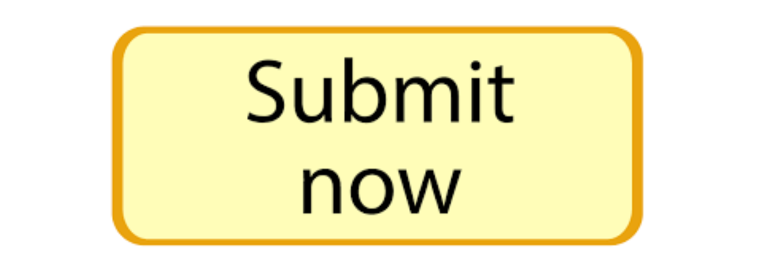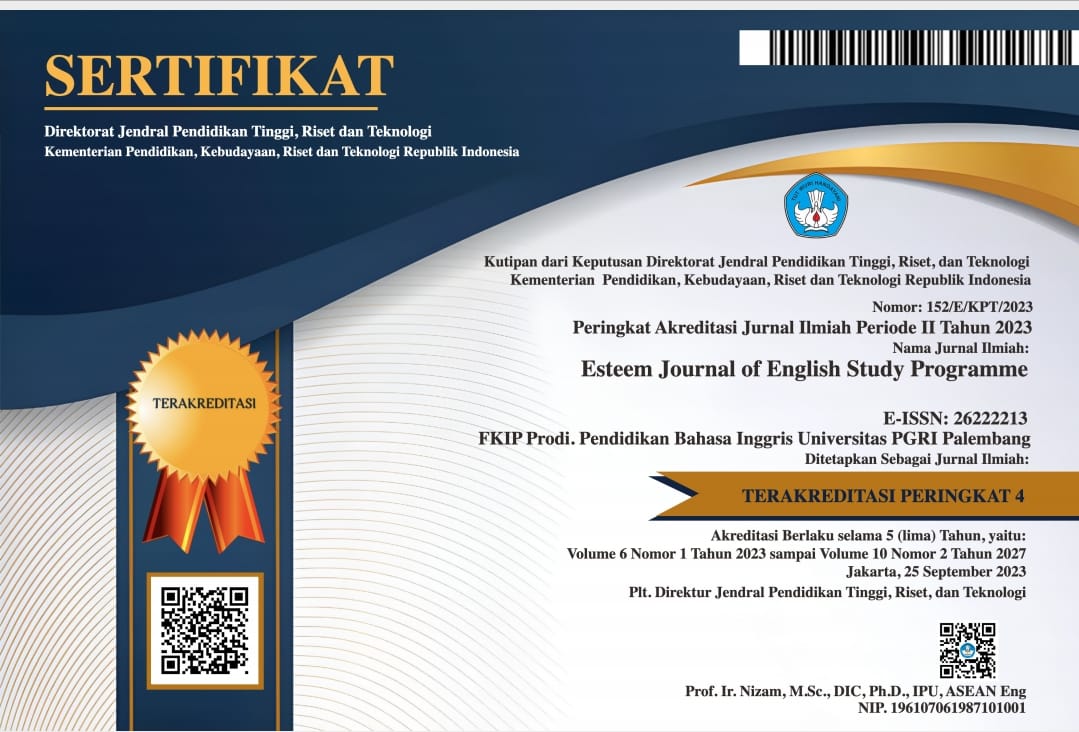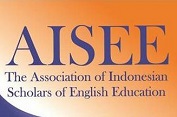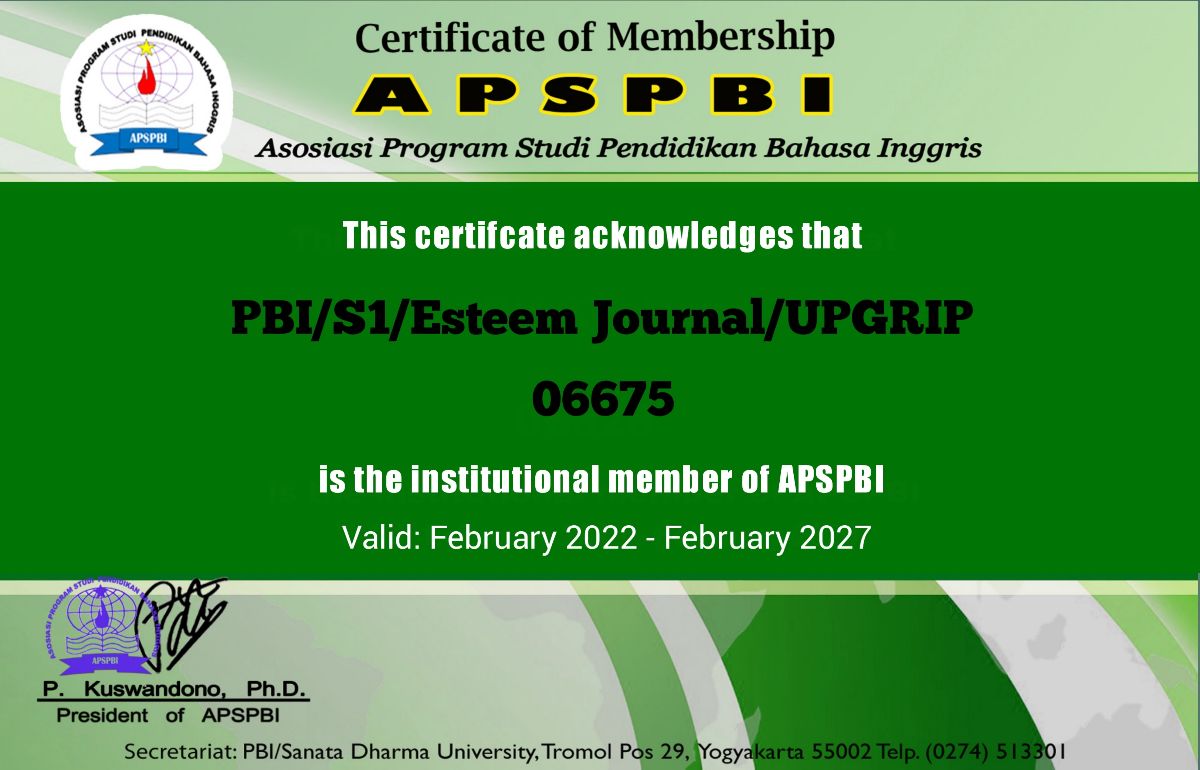STUDENTS’ PERCEPTION ON THE IMPLEMENTATION OF WORDWALL
DOI:
https://doi.org/10.31851/esteem.v8i1.18148Keywords:
Perception, word wall, EnglishAbstract
This study explores the impact of word walls in enhancing student learning motivation, addressing factors both internal and external to students. The purpose of this research is to examine student perceptions of the application of word walls. A qualitative approach was used, involving questionnaires and interviews as data collection instruments. The research respondents consisted of 33 tenth-grade students from SMA Negeri Plus Banyuasin III. The results indicate that word walls play a significant role in boosting student interest in learning, expanding vocabulary, and supporting the acquisition of new knowledge through reading books. Additionally, word walls contribute to the development of students' reading, writing, and speaking skills. Based on these findings, it is concluded that word walls are an effective tool for motivating students to engage in their learning process. It is recommended that educators consider incorporating word walls into their teaching strategies to improve student engagement and language development.
References
Agung, A. S. N., & Surtikanti, M. W. (2020). Students’ Perception of Online Learning during COVID-19 Pandemic: A Case Study on the English Students of STKIP Pamane Talino. SOSHUM : Jurnal Sosial Dan Humaniora, 10(2), 225–235. https://doi.org/10.31940/soshum.v10i2.1316
Akram, H., Abdelrady, A. H., Al-Adwan, A. S., & Ramzan, M. (2022). Teachers’ Perceptions of Technology Integration in Teaching-Learning Practices: A Systematic Review. Frontiers in Psychology, 13(June), 1–9. https://doi.org/10.3389/fpsyg.2022.920317
Aleksius, M., Lake, F., Werang, E. A., & Seran, M. F. (2022). Exploring EFL Students’ Perceptions of Google Classroom as Learning Management System. VELES Voices of English Language Education Society, 6(1), 176–187. https://doi.org/10.29408/veles.v6i1.5113
Atkinson, D. (1997). A critical approach to critical thinking in TESOL. TESOL Quartely, 31, 71–94. Atkinson, D., & Ramanathan, V. (1995). Cultures of writing: An ethnographic comparison of Ll and L2 University writing language programs. TESOL Quarterly, 29, 539–568.
Bereiter, C., & Scardamalia, M. (1987). The psychology of written composition. Erlbaum. Bernard, R. M., Zhang, D., Abrami, P. C., Sicoly, F., Borokhovski, E., & Surkes, M. A. (2008). Exploring The structure of the watson–glaser critical thinking appraisal: One scale or many subscales?. Thinking Skills and Creativity, 3, 15–22.
Bui, G., & Kong, A. (2019). Metacognitive instruction for peer review interaction in L2 writing. Journal of Writing Research, 11(2), 357–392. Camp, H. (2012). The psychology of writing development—and its implications for assessment. Assessing Writing, 17(2), 92–105.
Chafee, J. (2015). Critical thinking, thoughtful writing (6th ed.). Cengage Learning.
Cottrell, S. (2017). Critical thinking skills: Efective analysis, argument and refection. Bloomsbury Publishing.
Daar, G. F., Supartini, N. L., Sulasmini, N. M. A., Ekasani, K. A., Lestari, D., & Kesumayathi, I. A. G. (2023). Students’ Perception of the Use of Learning Management System in Learning English for Specific Purpose During the Pandemic: Evidence From Rural Areas in Indonesia. Journal of Language Teaching and Research, 14(2), 403–409. https://doi.org/https://doi.org/10.17507/jltr.1402.16
D’Alessio, F., Avolio, B., & Charles, V. (2019). Studying the impact of critical thinking on the academic Performance of executive MBA students. Thinking Skills and Creativity, 31, 275–283.
De Silva, R., & Graham, S. (2015). The efects of strategy instruction on writing strategy use for students of Diferent profciency levels. System, 53, 47–59.
Efklides, A. (2001). Metacognitive experiences in problem solving: Metacognition, motivation, and selfregulation. In A. Efklides, J. Kuhl, & R. M. Sorrentino (Eds.), Trends and prospects in motivation Research (pp. 297–323). Kluwer.
Efklides, A. (2006). Metacognition and afect: What can metacognitive experiences tell us about the learning process?. Educational Research Review, 1, 3–14.
Efklides, A. (2008). Metacognition: Defning its facets and levels of functioning in relation to self-regulation and co-regulation. European Psychologist, 13, 277–287 Flavell, J. H. (2004). Theory-of-Mind development: Retrospect and prospect. Merrill-Palmer Quarterly, 50, 274–290.
Flower, L., & Hayes, J. R. (1980). The dynamics of composing: Making plans and juggling constraints. In L. Gregg & E. Steinberg (Eds.), Cognitive processes in writing (pp. 31–50). Erlbaum.
Gammil, D. (2006). Learning the write way. The Reading Teacher, 59(8), 754–762.
Graham, S., & Harris, K. (2000). The role of self-regulation and transcription skills in writing and writing development. Educational Psychologist, 35, 3–12.
Graham, S. (2006). Writing. In P. A. Alexander & P. H. Winne (Eds.,), Handbook of educational psychology (pp. 457–478). Mahwah: Lawrence Erlbaum.
Grigorenko, E. Mambrino, & D. D. Preiss (Eds.), Writing a mosaic of new perspectives (pp. 221–239). Psychology Press
Hacker, D. J., Keener, M. C., & Kircher, J. C. (2009). Writing is applied metacognition. In D. J. Hacker, J. Dunlosky, & A. C. Graesser (Eds.), Handbook of metacognition in education (pp. 154–172).
Hall, N. C., & Goetz, T. (Eds.). (2013). Emotion, motivation, and self-regulation: A handbook for teachers. Bingley.
Halpern, D. F. (1998). Teaching critical thinking across domains: Dispositions, skills, structure training, and metacognitive monitoring. American Psychologist, 53(4), 449–455.
Harris, K. R., Santangelo, T., & Graham, S. (2010). Metacognition and strategies instruction in writing. In H. S. Waters & W. Schneider (Eds.), Metacognition, strategy use, and instruction (pp. 226–256). The Guilford Press.
Hedgcock, J. S. (2012). Second language writing processes among adolescent and adult learners. In E. L.
Herdina, G. F., & Ningrum, A. S. B. (2023). Teachers’ Perceptions and Challenges in Integrating Technology in English Reading Course: A Systematic Research Review. English Education:Journal of English Teaching and Research, 8(1), 91–101. https://doi.org/10.29407/jetar.v8i1.19133
Kaforina, M., Mulyadi, M., & Jaya, A. (2023). the Students’ Personality Based on Their Reading Attitude. Esteem Journal of English Education Study Programme, 7(1), 12–23. https://doi.org/10.31851/esteem.v7i1.12654
Muhtar, I. Y., Pammu, A., & Nasmilah, N. (2021). Students’ Perceptions of The Use Of ‘TELL’ in English Learning Process in Bosowa University Makassar. ELS Journal on Interdisciplinary Studies in Humanities, 4(4), 474–484. https://doi.org/10.34050/elsjish.v4i4.19116
Nazara, S. (2017). Students’ perception on EFL speaking skill development. Journal of English Teaching, 1(1), 28–43.
Osakue, E. E., Ph, D., & Thomas, G. (2011). Students ’ Perception of Project Assisted Learning. Latin American and Caribbean Journal of Engineering Education, 5(1), 12–17.
Pardede, P. (2020). Secondary School EFL Teachers’ Perception of ICT Use in Learning and Teaching: A Case Study in Greater Jakarta. JET (Journal of English Teaching), 6(2), 111–121.
Putri, A. D., Jaya, A., & Marleni, M. (2023). Exploring the Students’ Speaking Ability Based on Their Different Personalities. Esteem Journal of English Education Study Programme, 6(1), 10–16. https://doi.org/10.31851/esteem.v6i1.10203
Downloads
Published
Issue
Section
License
Copyright (c) 2025 Tata Regita Shervaty Irawan, Aelista Dwi Wahyuni, Tahrun

This work is licensed under a Creative Commons Attribution-NonCommercial-ShareAlike 4.0 International License.
Copyright Notice
Authors who publish with this journal agree to the following terms:
In order to assure the highest standards for published articles, a peer review policy is applied. In pursue of the compliance with academic standards, all parties involved in the publishing process (the authors, the editors and the editorial board and the reviewers) agree to meet the responsibilities stated below in accordance to the Journal publication ethics and malpractice statement.
Duties of Authors:
- The author(s) warrant that the submitted article is an original work, which has not been previously published, and that they have obtained an agreement from any co-author(s) prior to the manuscript’s submission;
- The author(s) should not submit articles describing essentially the same research to more than one journal;
- The authors(s) make certain that the manuscript meets the terms of the Manuscript Submission Guideline regarding appropriate academic citation and that no copyright infringement occurs;
- The authors(s) should inform the editors about any conflict of interests and report any errors they subsequently, discover in their manuscript.
Duties of Editors and the Editorial Board:
- The editors, together with the editorial board, are responsible for deciding upon the publication or rejection of the submitted manuscripts based only on their originality, significance, and relevance to the domains of the journal;
- The editors evaluate the manuscripts compliance with academic criteria, the domains of the journal and the guidelines;
- The editors must at all times respect the confidentiality of any information pertaining to the submitted manuscripts;
- The editors assign the review of each manuscript to two reviewers chosen according to their domains of expertise. The editors must take into account any conflict of interest reported by the authors and the reviewers.
- The editors must ensure that the comments and recommendations of the reviewers are sent to the author(s) in due time and that the manuscripts are returned to the editors, who take the final decision to publish them or not.
Authors are permitted and encouraged to post online a pre-publication manuscript (but not the Publisher final formatted PDF version of the Work) in institutional repositories or on their Websites prior to and during the submission process, as it can lead to productive exchanges, as well as earlier and greater citation of published work (see The Effect of Open Access). Any such posting made before acceptance and publication of the Work shall be updated upon publication to include a reference to the Publisher-assigned DOI (Digital Object Identifier) and a link to the online abstract for the final published Work in the Journal.





























